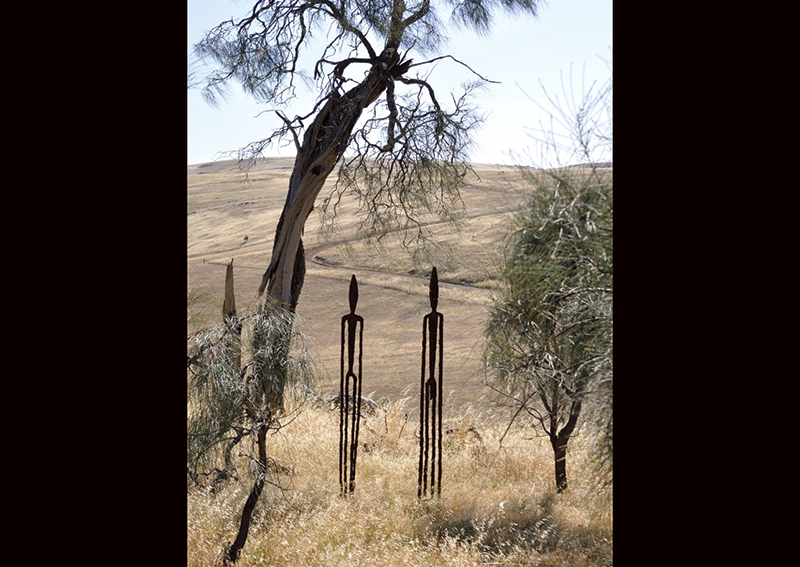Silver linings: Land and Light

Land and Light, Greg Johns and Michal Kluvanek, West Gallery Thebarton
In 1947, the French writer and politician André Malraux predicted that art history and the history of sculpture in particular, had become “the history of that which can be photographed”. Such thinking reflected the close relationship that photography and art had developed since the year 1839 when almost simultaneously, Louis-Jacques-Mandé Daguerre in France and Henry Fox Talbot in England, through their experiments with chemicals and light, respectively created the daguerreotype and the negative/positive process.
Photography is a hungry beast, ever in search of subjects. Sculpture proved to be a very compliant subject, in part because of its ready-made aesthetics and also its inertness which allowed for extended exposure times. In an increasingly crowded field, the photography of Auguste Rodin’s work in the very late 19th century set new benchmarks for creative interpretation. Rodin stage-managed the photography of his work including documentation of his sculptures through successive stages of production.
The handheld, portable cameras that came into common usage in the 1920s allowed photographers to roam freely in their visual interrogation of sculptures. In the process, visual surroundings and contexts were admitted and became part of the lexicon of modern photography of sculpture.
From being relative bystanders, sculptors adopted active roles in harnessing photography’s ability to posit alternative realities. Brancusi, for example, while a close associate of leading photographers, preferred to photograph his own work, usually assembling and reassembling pieces of sculpture, bases and pedestals.
Today, it is a given that creative (as opposed to documentary) photography has a parallel role to play in riffing off artworks in the spirit of an active respondent to what these works may be saying. But occasionally there are limits. Some public sculptors like Greg Johns envisage particular visual roles for their works in the public domain. This is particularly apparent in the siting of his own work at Palmer where viewpoints, distance and scale have been carefully factored in to the siting of every piece. But once installed, each work, be it one of his hieratic Horizon Figures set on an escarpment or an Observer within a grove of she-oaks, is set free to survive as best it can. Here the visual outcomes are uncertain.
On a mid-summer’s day, the light falls like a hammer on all things beneath. Shadows shrink to slivers and small pools. Metal reflects and dissolves form. Large sculptures can be reduced to dashes and dots on an epic canvas defined by a landmass meeting the sky. Enter photography and its capacity to ‘take you there’ on its own terms. Michal Kluvanek met Johns while at art school in the mid-1970s. The two artists’ respective practices have taken different directions but have always found common ground in response to place – plus as Kluvanek reminds us, “Both Greg and I are metal workers … In black and white photography, the black is actually silver salts.”
Johns’ philosophy in terms of Australian identity being imbedded in the land is well-known. Kluvanek, also, has spent an entire, 40 years of professional practice capturing and responding to the nuances of particular Australian landscapes.
Kluvanek is presenting three sequences of photographs; Thebarton (the artist’s immediate neighborhood), Palmer and Kangaroo Island. In this body of work he demonstrates the skill and experience of someone who has found a way to conduct a conversation with light and land through the agency of the lens.
The Thebarton series shows him in sparkling form, toying with light effects with a cast of shopping trolleys and milk cartons. The Kangaroo Island photographs are uniformly fresh and insightful. In responding to terrain and light, Kluvanek admits that he is an opportunist, seizing on moments when the light is just so. This instinct to nail the moment is as evident in very intimate takes on nature such as scraps of foam on a shore or grand vistas of nature with all stops out. His poetic photographs of Johns’ sculptures at Palmer are reminders that even things of stone and steel are subject to light in ways that draw attention to not only form but in particular, the relationship that operates between art and land.
Land and Light
Greg Johns and Michal Kluvanek
West Gallery Thebarton
Thursday, October 11
to Sunday, November 11
westgallerythebarton.com.au
Image: Greg Johns, The Observers, 2014, Palmer installation. Photo: Ashley Starkey